 In this picture taken on Oct 2, 2019 a Tokyo Electric Power Company (TEPCO) researcher shows processed water where tritium remains, at a lab in Fukushima Dai-ichi nuclear plant in Okuma, Fukushima prefecture. (HITOSHI KATANODA / POOL / AFP)
In this picture taken on Oct 2, 2019 a Tokyo Electric Power Company (TEPCO) researcher shows processed water where tritium remains, at a lab in Fukushima Dai-ichi nuclear plant in Okuma, Fukushima prefecture. (HITOSHI KATANODA / POOL / AFP)
A Japanese panel will recommend to the government that swelling volumes of treated radioactive water from the wrecked Fukushima nuclear plant should be released into the ocean or evaporated.
Storage tanks at the site, that hold water treated by a nuclide-removal facility called ALPS, are forecast to be full by mid-2022, and space for building more is scarce
A Ministry of Economy, Trade and Industry panel agreed to the options during a meeting Friday in Tokyo and will send the recommendations in a report to Prime Minister Shinzo Abe’s government, which will make the final decision on how to proceed. The draft report made public at the meeting Friday didn’t include a proposed timing for the release.
Storage tanks at the site, that hold water treated by a nuclide-removal facility called ALPS, are forecast to be full by mid-2022, and space for building more is scarce. While South Korea and local fishing groups in Fukushima prefecture strongly oppose an ocean release, discharges are common practice in the industry and would likely meet global guidelines.
ALSO READ: Japan faces decision over contaminated Fukushima water
Any water that is released into the environment will be re-purified and diluted to meet standards and the discharges would take place over decades, according to December report from METI.
Tepco was holding enough of the treated water to fill 400 Olympic-sized swimming pools at the site, as of Oct 31. On average, about 170 cubic meters of water becomes tainted daily, which includes water that is pumped into the plant to keep the remaining fuel inside cool.
READ MORE: Japan govt proposes Fukushima water release to sea or air


